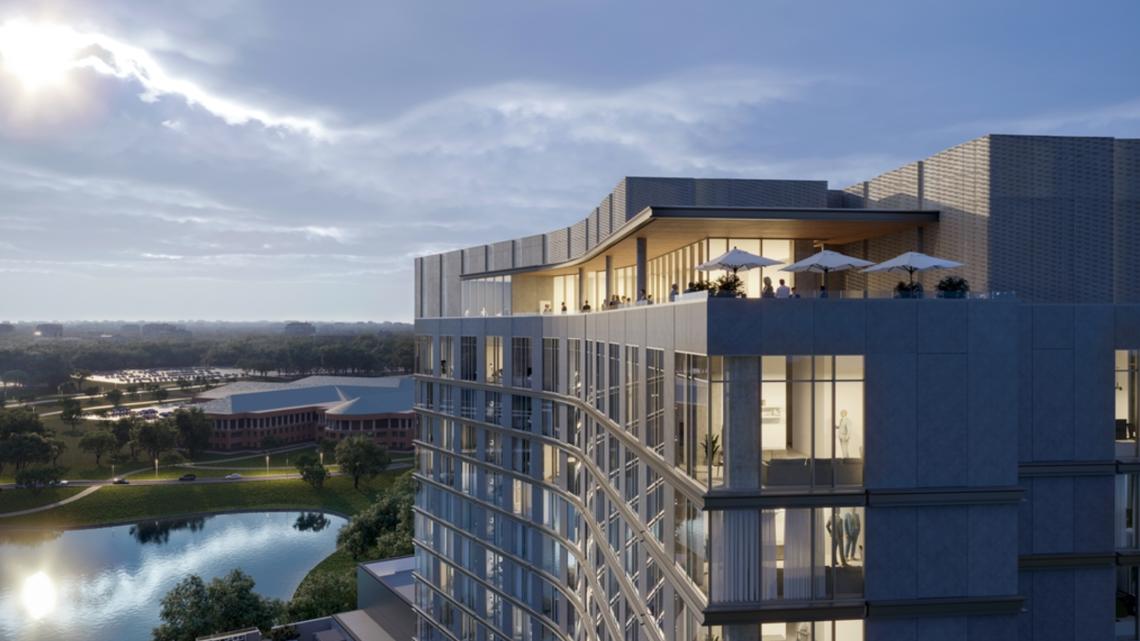PLANO, Texas — Editor's note: The following story was first published in the Dallas Business Journal.
An upcoming grand and unique hotel in Plano has generated significant buzz around how exactly the project will fuse Japanese sophistication with big Texas, Southern-style charm.
The Miyako Hotel, located on the south side of Campus at Legacy near Toyota’s North America headquarters, aims to not only cater to Japanese employees visiting the company, but also to a broader public looking for a special and authentic experience. It is expected to deliver in mid-2027.
Garfield Public-Private LLC was recently announced as the developer for the hotel — five years after the project was first announced. The Dallas-based firm will be responsible for finalizing designs and permits to bring the hotel closer to the construction phase.
Garfield will collaborate with the design firm for the hotel, Gensler, which began working on initial design plans for the project in April 2019. However, the Covid-19 pandemic delayed some of these plans, and the architecture firm has been working more closely on the project for the last two years.
Gensler's design team of around 10 people is now working on the design development phase, which includes refining preliminary plans, selecting building materials and finishes and integrating electric and plumbing systems into the site. Soon after this is complete, both teams will be closer to deciding on construction costs and a guaranteed maximum price for the project.
Dallas Business Journal spoke to Gensler’s design director Alejandro Guerrero to learn more about the project that’s been in the works since 2019.
Blending Japanese aesthetics
Overall, the hotel plans to subtly reflect Japanese culture and create an authentic experience for guests, without feeling overly curated, Guerrero said. Elements of Japanese style — including motifs on walls, wallpaper, tea pots in the room and even the configuration of the bathrooms — will be woven throughout the hotel.
"Everything tries to have a little nod to the Japanese aesthetic," he said.
Other small touches include an exterior lighting scheme inspired by luminescent paper lanterns, often used in Asian celebrations. A custom design feature on the outside of the hotel will also make the building visible from afar at night.
Interior lighting will embrace an understated, clean style to “accompany the finer design touches typical of modern Japanese luxury design,” Guerrero said.
Kintetsu Enterprises Co. of America, the owner and builder of the hotel, is also considering bringing some of its art collection to the hotel, which will add another layer of authenticity. Public areas of the hotel plan to function as gallery spaces, providing another element for guests to experience during their stay.
Japanese garden plans
A Japanese garden planned at the site will be a testament to the marriage of the two cultures. It plans to feature cherry blossom trees and Japanese maples along with some plants native to North Texas, which helps preserve water and maintain the region's natural biodiversity.
Blending two differing outdoor aesthetics may be even more of a meticulous process than designing the indoors. In Japanese architecture, the outdoors are heavily curated and the landscape gets treated like a work of art. On the other hand, Texas outdoor landscaping is more casual and tends to feature large porches.
“Because of our climate, it's also important that the outdoor (environment) is sheltering the occupants from the outside,” Guerrero said.
The garden itself, located closer to the hotel, will borrow from Japanese culture, with several water features, shading elements and even some sculptures. Gravel and sand are some examples of earthy materials that will be used in the garden.
Furthermore, the garden won’t be far from the 6-acre retention pond, which plans to be used to create the sensation of a luxury hotel by a body of water.
'Personalized' hospitality culture
Japan’s hospitality-centric culture revolves around personalized care and attention to guests, which is slightly different from Western customer service that cares more about the whole experience.
“It’s the way that they greet you, the way that they receive you, the way that there’s a personal attention to the guests in finding your way and navigating through the spaces ... that’s something that’s going to be very unique and very special as a distinguishing factor between this hotel and others around the area,” Guerrero said.
Food is a key way the hotel tries to connect with guests and allows people to immerse themselves in Japanese culture. A special bakery selling decorated Japanese pastries that almost resemble artwork will be available for both hotel guests as well as visitors.
A rooftop bar will also offer teppanyaki, which is similar to hibachi dining. There will also be several opportunities for private dining experiences that promise to deliver even more individualized attention to guests.


In addition to an expansive pool for people to swim laps in, there will also be some spa-like amenities on site, including outdoor steam rooms and a jacuzzi.
Once it comes together, Guerrero said he anticipates the hotel will be like no other in North Texas. There are two Miyako hotels in the United States, both in California.
“It’s going to be very authentic in the sense it doesn’t try to bring a theme, it doesn’t try to bring elements that are going to feel out of place,” he said. “The idea is to very elegantly, and very subtly reflect Japanese culture to the point that it becomes a blend.”
More Texas headlines:



